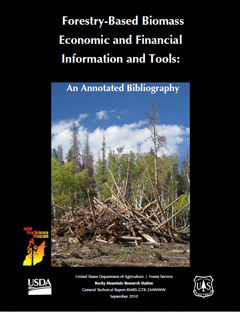Displaying 161 - 180 of 188
Meyer
ANNOTATION: This paper briefly describes the history of the logging industry in the United States. Specifically, harvesting technology and methods are discussed. Many significant and far-reaching changes have taken place in the logging industry since its…
Year: 1981
Type: Document
Source: FRAMES
Robatcek
ANNOTATION: The purpose of the paper is to discuss some of the implications of improved residue utilization on timber sales activities. Improved residue utilization on timber sales requires new and innovative economic and practical approaches on timber…
Year: 1981
Type: Document
Source: FRAMES
Sampson
ANNOTATION: This paper presents an evaluation of the test results and uses the results to predict the future of in-woods chipping Economic analysis of data from a demonstration test showed that in-woods debarking-chipping was only marginally competitive…
Year: 1981
Type: Document
Source: FRAMES
Host
ANNOTATION: This report, part of a larger study of factors affecting the utilization of small trees, deals with the impact of capital investment on logging productivity. Equipment selling price is not an indicator of machine productivity. Translated into…
Year: 1981
Type: Document
Source: FRAMES
Schweitzer
ANNOTATION: As the values of wood products increase, there are more economic opportunities to utilize residues. This is true both for dead-and-down materials and for previously unharvested stands which, together, make up the potential economic residues…
Year: 1981
Type: Document
Source: FRAMES
Smith
ANNOTATION: The framework for harvesting and utilization opportunities for forest residues includes a number of long standing as well as recently enacted statutes. Air and water quality standards as set forth in legislation also have an effect on…
Year: 1981
Type: Document
Source: FRAMES
Henley
ANNOTATION: This study highlights the results of a study of the economic feasibility of harvesting dead lodgepole pine for fuel and products. Costs, production rates, and recoverable wood volumes were obtained from a 3-month study of a whole-tree logging…
Year: 1981
Type: Document
Source: FRAMES
Sturos
ANNOTATION: Three processes have been developed in the United States, one in Canada, and one in Finland for improving the quality of whole-tree and forest residue chips. They have potential application individually or in combination. Two of them have been…
Year: 1981
Type: Document
Source: FRAMES
Van Hooser
ANNOTATION: In this paper, it is outlined how Resources Evaluation has treated forest residue in the past, what changes have been made recently to more adequately address the forest residue, and finally to consider what changes will have to be made in the…
Year: 1981
Type: Document
Source: FRAMES
Withycombe
ANNOTATION: Whatever decisions are to be made concerning the possible use of forest residues, questions always arise about the costs of collecting and transporting them to a place where they might be used. The residue cost model consists of a series of…
Year: 1981
Type: Document
Source: FRAMES
Withycombe
ANNOTATION: The potential markets for forest residues can be classified into four primary categories. This paper deals with each of these categories separately, and attempts to indicate some of the major influences which are expected to change the trend…
Year: 1981
Type: Document
Source: FRAMES
Gonsior
ANNOTATION: This paper analyzes harvesting per se as well as its role in the total forest management picture. Models are presented for testing the sensitivity of total management cost and the harvesting components of cost to alternative silvicultural,…
Year: 1981
Type: Document
Source: FRAMES
Fahey
ANNOTATION: Relative values per ton of log input are developed for poles, corral poles, house logs, lumber, studs, veneer, chips, and fuel on a current market basis. The techniques to reevaluate on different markets are demonstrated. Product…
Year: 1981
Type: Document
Source: FRAMES
Benson, Schlieter
ANNOTATION: In the northern Rocky Mountains, 350-450 million cubic feet (9.9 to 12.7 million cubic meters) of logging residue is generated each year. Up to 60 percent of the residue material is technologically suitable for wood products, but condition,…
Year: 1981
Type: Document
Source: FRAMES
Barger, Benson
ANNOTATION: Forest residues utilization research has included case studies of the efficiency of existing harvesting systems in achieving close fiber utilization. Field evaluations included the use of in-woods chipping systems in gentle terrain; crawler…
Year: 1981
Type: Document
Source: FRAMES
Barger
ANNOTATION: The purpose of this publication is to report the results of research conducted by the Residues R&D Program in harvesting and utilization opportunities for forest residue. Additionally, to provide a record of proceedings of the 3-day…
Year: 1981
Type: Document
Source: FRAMES
Arola, Miyata
ANNOTATION: This paper illustrates the potential of harvesting wood for industrial energy, based on the results of five harvesting studies and presents information on harvesting operations, equipment costs, and productivity. It further discusses…
Year: 1981
Type: Document
Source: FRAMES
Johnson
ANNOTATION: This paper describes the state of the wood products industry and the economy of western Montana in the late 1970s. Forty to forty-five percent of the earnings in western Montana's basic or export industries at the time came from the wood…
Year: 1981
Type: Document
Source: FRAMES
Keegan
ANNOTATION: The goal of this project is to estimate the cost of harvesting and transporting forest residues to processing centers in the northern Rocky Mountains. Regionwide estimates are to be made based on the detailed analyses of the volumes and types…
Year: 1981
Type: Document
Source: FRAMES
Snell, Brown
ANNOTATION: Procedures are given for estimating weights of potential residue from Douglas fir and western hemlock. Preliminary estimates are given for six other species. Estimates are provided in pounds per tree and pounds per square foot of basal area…
Year: 1980
Type: Document
Source: FRAMES

